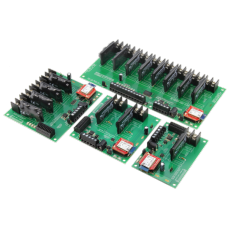Bluetooth Solid State Relay Controllers
Bluetooth Solid State Relay Controllers from NCD
NCD Bluetooth Solid State Relay Controllers make it easy for computers of all types to control relays and monitor analog inputs. Bluetooth Relay boards allow you turn relays on or off, flash relays continuously, control relays for a duration of time, and control relays in groups using a cross-platform compatible Bluetooth interface. NCD ProXR Lite series controllers are a widely adopted standard used by industry for many years. Equipped with your choice of 1, 2, 4, or 8 on-board relays, the ProXR Lite series Bluetooth Relays suit the needs of most of our customers. Integrated Analog to Digital Converters may be used to manually control the relays, or they may be used to read external sensors. Equipped with 8 or 10-Bit resolution, the ADC built into NCD Bluetooth Relays add tremendous flexibility for various application requirements.
Getting Started with an NCD Bluetooth Relay
Start by downloading Base Station at https://ncd.io/start. Plug in one of our Bluetooth relay boards and run Base Station. Base Station is a tool designed to teach you all the features built into your controller and provide you with example commands. NCD Bluetooth Relays mount as a virtual COM port on your PC. Base Station was written for Windows using Visual Studio (source code available). Base Station shows you all the commands you need for controlling relays and monitoring external sensors.
How to Order our Bluetooth Relays
Start by clicking the “Buy Now” button on the right. Next, choose how many on-board relays you need (up to 8 in this series). Select the relay options in the red box for 5 or 10-Amp mechanical relays. Choose the type of Bluetooth interface connector you require and add a power supply if needed. We have been manufacturing many varieties of Bluetooth Relay boards with tens of thousands of users all over the world! We were the first company to produce Bluetooth devices for switching applications and we are the most widely adopted industrial standard!
Need more Relays?
No Problem! We have expandable ProXR Relay controller available if you need more relays, just click here. Simply choose the Bluetooth option during checkout. NCD ProXR series controllers are field serviceable with a very long production history adopted by the largest companies in the world!
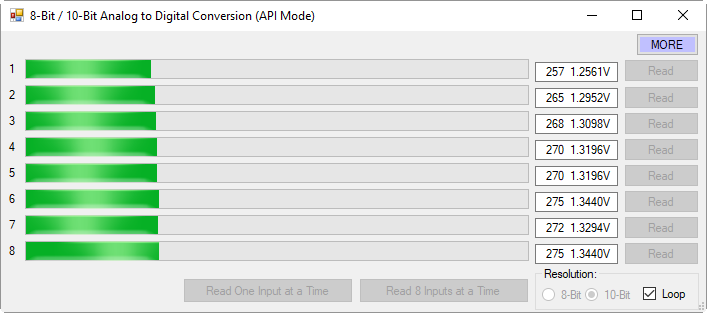
ProXR Analog to Digital Inputs are used to Read External Sensors or Manually Control On-Board Relays
AD8 8-Channel 8/10-Bit Analog to Digital Converters
This controller is equipped with 8-Channels of 8/10-Bit Analog to Digital Converters, capable of reading analog voltages from 0 to 5 Volts DC. The ADCs on this controller allow monitoring of external sensors or contact closure input detection. Connect external temperature sensors, light sensors, current sensors, buttons, switches, or anything else that generates a 0-5VDC analog or contact closure output. With 8-bit resolution, analog inputs will convert 0-5 Volt signals into a value from 0 to 255. With 10-bit resolution, values of 0 to 1023 may be measured. Input resolution is software selected. Simply ask the controller for the analog value of each input, and the controller instantly responds.
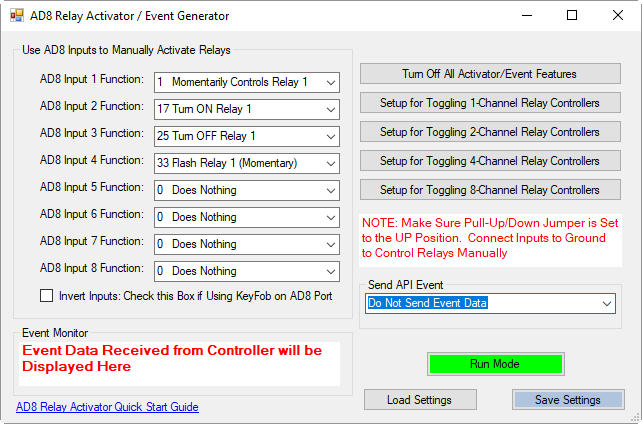
Use the Relay Activator to Configure Analog Inputs for Direct Control of Relays
Relay Activator and Analog Inputs
The Relay Activator control panel allows analog inputs to directly control relays. Simply connect the analog inputs to buttons or switches and trigger basic relay on or off functions to take manual control of the on-board relays. The Relay Activator control panel allows you to define 8 functions for each of the 8 inputs. Functions include turning relays on or off, toggling the state of relays, momentarily flash a relay, momentarily toggle the flashing function of a relay, turn all relays on, turn all relays off, and push notification events. When push notification events are configured, the controller generates a packet of data every time the inputs change state.
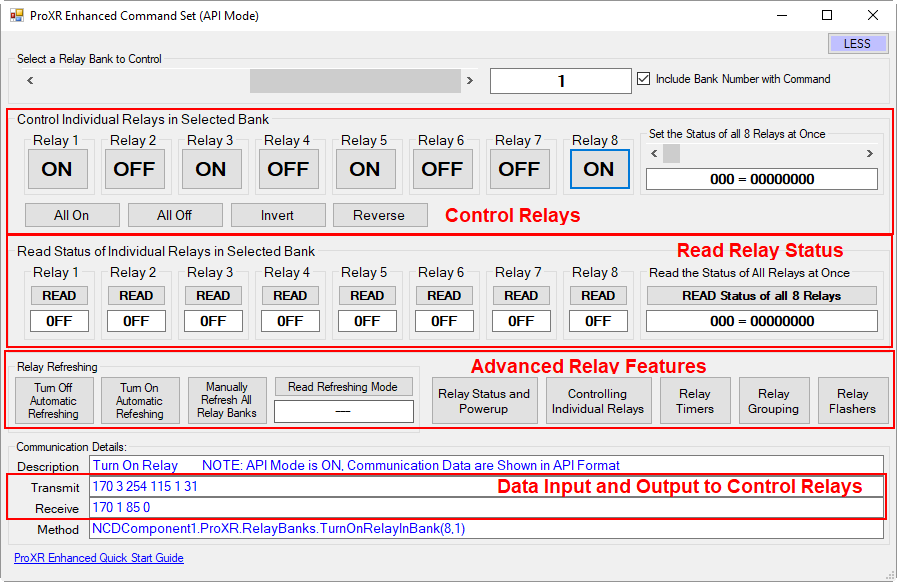
Base Station Software Controlling NCD Relay Controllers
Base Station Software
Base Station Software was designed to help you learn the ProXR command set. Explore ProXR features using our Graphical User Interface. Watch data bytes flow to and from the board, so you easily understand the command execution process. There is no faster or easier way to learn how to automate than Base Station, as it was designed to work with our complete array of communication modules, including Wireless, Ethernet, USB, RS-232, and many more. You only need a Windows 8 or 10 Computer to Run Base Station. Base Station was written in Visual Studio, and we even provide the source code to help you on your way!
LabVIEW Relay Control Support Coming in 2018
We are pleased to announce that official LabVIEW relay control drivers will be supported beginning January of 2018. This is our first official release of LabVIEW drivers for ProXR series Relay controllers! We are finalizing the drivers and resources now. We will post in the News section as well as the Learn section of our site as soon as we are ready.
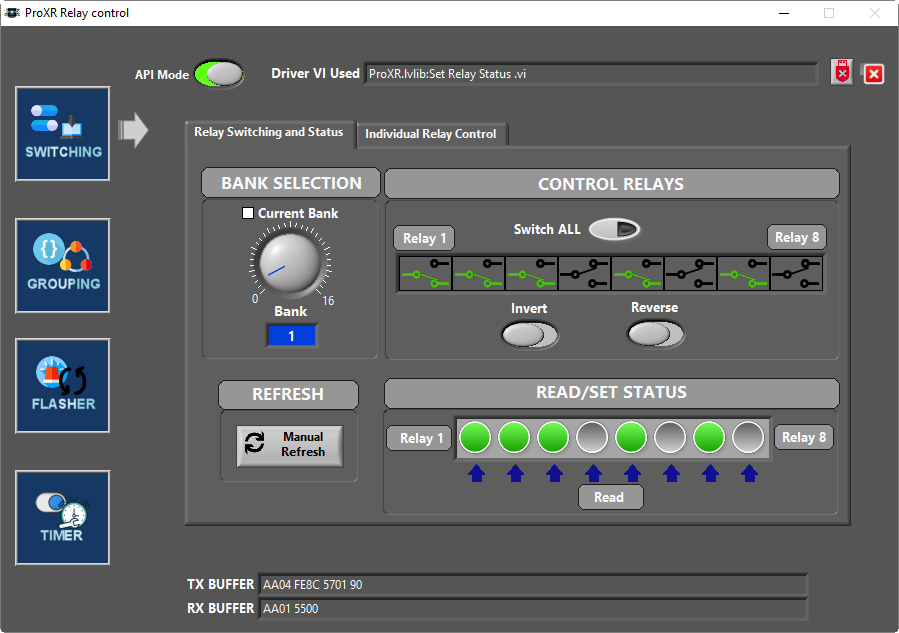
LabVIEW ProXR Relay Drivers
ProXR Lite vs. ProXR Series
ProXR Lite controllers are smaller, surface-mounted variants of the ProXR Series relay controllers. The firmware is nearly identical between the series with ProXR Lite being limited to 8 relays. Only the ProXR series includes a XR expansion port for relay expansion. ProXR Lite controllers are a lower-cost alternative to ProXR because they are machine manufactured in larger quantities. ProXR series controllers are currently manufactured with through-hole technology and socketed chips, making them field serviceable. ProXR Lite controllers are available with little as 1 or 2 relays while ProXR Series focuses on applications that require 4 or more relays.
ProXR Lite Communication Options
We take communications seriously, as we believe in a modular communications and firmware that properly supports scalability into future interface technologies. ProXR controllers support API communications, which effectively wrap every command with a header, payload, and checksum to ensure reliability. NCD API commands increase processing speed because no serial timeout is required prior to command processing. NCD API commands increase reliability, as only a proper checksum will authenticate a command and allow it to process. When we first implemented API, internet communications via a TCP/IP socket could be realized because the timing problems of internet communications were eliminated. While API is optional, it is strongly advised. Our Base Station software uses API communications, so it’s possible to control a ProXR controller over the internet after configuring port forwarding on your router.
ProXR series controllers are the world’s most adaptable controllers, capable of communicating with a wide variety of communication options. Pick any of your favorite communication technologies: Bluetooth, USB, WiFi, Ethernet, Ethernet Web-i WebRelay, 802.15.4 Wireless, ZigBee Mesh, Key Fob, or RS-232. ProXR easily adapts to the communication technologies you need most. We are committed to modular communications, so your ProXR series controllers can easily be retrofitted for other applications as your needs change. ProXR controllers are never obsolete, as we are actively releasing new communication technologies that greatly enhance the connectivity of our ProXR series controllers.
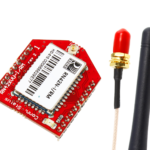
Bluetooth
Bluetooth is a easy way to add wireless communications to the NCD Industrial product line. The Bluetooth communications option acts as a transparent serial port between your computer and NCD devices. Simply pair the device with your computer and access the device through the COM port that is associated with the Bluetooth communications module.
Solid State Relays
Solid state relays are ideal for agricultural switching applications, or remotely located switching. SSRs are frequently chosen to control pumps, valves, solenoids, lights, and other high-reliability applications. NCD solid-state relay controllers do not include solid-state relays, but you will have the option to choose the type of solid state relays you require when customizing your product. This controller is designed specifically to fit select Crydom solid-state relays, but may be compatible other solid-state relays made by other companies.
Wireless Range Testing Setup
This video tells you the set up that we used to get real world ranges on our wireless communication modules.
Finding the Com Port
Learn how to find the COM Port on your windows based computer. You can also use Base Station to find the COM Port of your Relay Controller. Base Station can be downloaded at ncd.io/start.
Analog to Digital Converter Introduction
Learn the Basics of Analog to Digital Conversion. Many of our boards have analog to digital inputs directly on the board. These ADC inputs are great for monitoring sensors and controlling relays from software based on these sensor readings. This video will show you how, why, and when to use them.
Introduction to Relay Control
This video will guide you in determining which relay controller you need for your application as well as a general overview of the differences between Relay Options. If you're new to our products or just need a refresher for a new application this is a great place to start.
Induction Suppression
Learn about Induction and how it comes into play with Relay Controllers. Induction suppression can make your Relay Control applications intermittent and unreliable. This video will show you what causes it, how to avoid it, and how to account for it in your application.
Enter the code in the box below:
